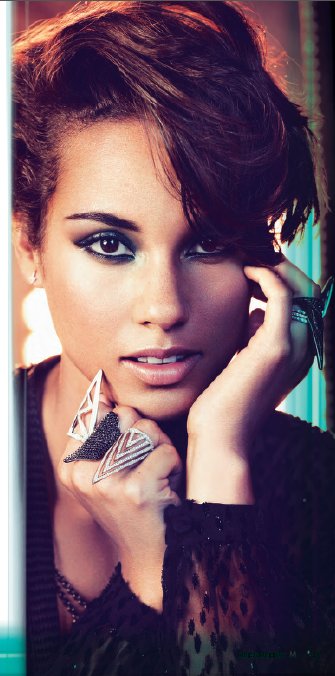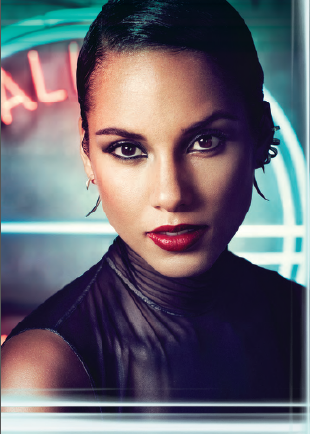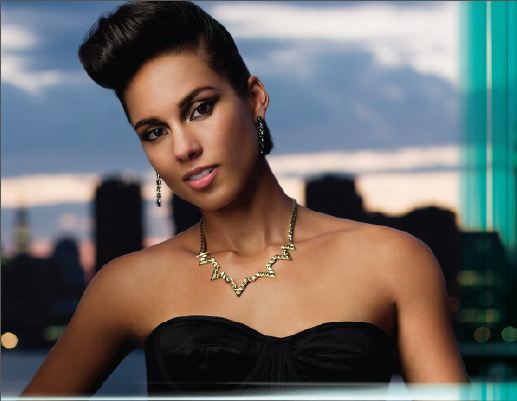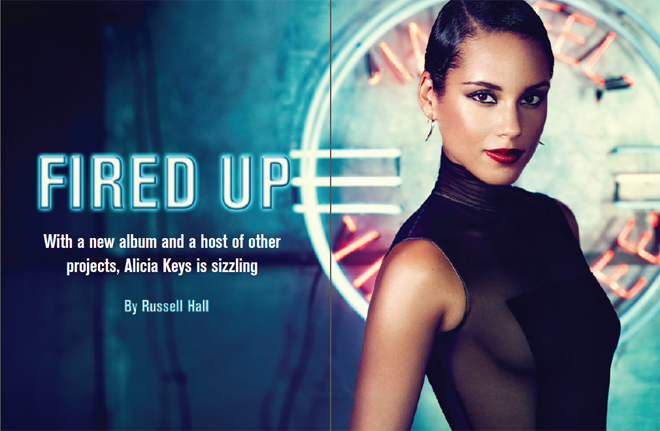FIRED UP – With a new album and a host of other projects,
Alicia Keys is sizzling
Sometimes an offhand comment can lead to magic. That’s exactly what happened to Alicia Keys as she began making her new album. Taking note of Keys’ energized demeanor, an interviewer called the 31-year-old singer-songwriter a girl on fire. “That’s it!” Keys thought. “That describes everything I’m feeling. Now I just need to figure out what being a girl on fire sounds like. It’s all about having a vision for yourself.”
 It’s also about activity—lots of it. Since releasing her last album, 2009’s The Element of Freedom, Keys has shifted into a higher gear. Evidence of a renewed vigor arose shortly after she parted ways with longtime manager Jeff Robinson and assumed the reins of her career. In less than three years, Keys has produced and scored a Broadway play, directed a short film, designed a shoe line for Reebok, and developed an animated iPhone app for children. She also wrote the score for the feature film The Inevitable Defeat of Mister and Pete, set to premiere at the Sundance Film Festival in late January.
It’s also about activity—lots of it. Since releasing her last album, 2009’s The Element of Freedom, Keys has shifted into a higher gear. Evidence of a renewed vigor arose shortly after she parted ways with longtime manager Jeff Robinson and assumed the reins of her career. In less than three years, Keys has produced and scored a Broadway play, directed a short film, designed a shoe line for Reebok, and developed an animated iPhone app for children. She also wrote the score for the feature film The Inevitable Defeat of Mister and Pete, set to premiere at the Sundance Film Festival in late January.
Remarkably, this burst of creativity comes on the heels of new domestic responsibilities. In the summer of 2010, Keys married producer-songwriter Swizz Beatz, and later that year gave birth to their son, Egypt. “I’ve always been focused and driven,” she observes, “but this is another level. It’s not just about me or about how fast I can go. Motherhood simultaneously clarified who and how I want to be.”
Raised by her mother in Manhattan’s rough-and-tumble Hell’s Kitchen, Keys studied classical piano beginning at age 6, and graduated as valedictorian of New York’s prestigious Professional Performing Arts School at 16. Enrollment at Columbia University followed, but Keys dropped out to pursue a career in music. Mentored by industry legend Clive Davis, she released her debut album Songs in A Minor in 2001. The record sold 12 million copies worldwide and earned five Grammys.
Twenty-one at the time, Keys found herself being hailed as a beacon of a new type of R&B, one that infused established soul traditions with classical sophistication. The creative evolution she exhibited on subsequent albums—along with additional Grammy wins and platinum sales—confirmed the assessment. As Keys once said, “Sometimes I feel like I was born in the wrong decade. I was supposed to be doing this when Nina Simone was alive. There’s something special about the honesty, craftsmanship and integrity that existed among artists of her era.”
It’s in that spirit that Keys’ created her latest, Girl on Fire. Working from her Manhattan studio—dubbed the Oven—Keys spent more than a year crafting the album, juggling writing and recording with a laundry list of other projects. She also recruited an A-team of collaborators, deliberately seeking out many artists with whom she had never worked. Co-writers include Bruno Mars, Frank Ocean, “Babyface” Edmonds, Gary Clark Jr. and Scottish newcomer Emeli Sandé, and others.
The title track—which sprang to life after Keys, writer-producer Jeff Bhasker and producer Salaam Remi started fiddling around with computer-generated drum sounds—became the record’s catalyst. “We were working on some ideas when I mentioned I wanted to write a song called ‘Girl on Fire,’” she recalls. “We started playing with that idea. Suddenly the melodies and lyrics just flowed, and then there was this crazy beat. Eventually the chorus came out of it. We were trying for a big, aggressive sound, and it hit me, ‘That’s what a girl on fire sounds like!’ The sound built from there and everything started to flow organically. It doesn’t always happen that way, but it did that night.”
Other standouts include “101,” a towering, deeply intimate ballad sparked by a conversation between Keys and Sandé about love’s risks and rewards, and the autobiographical lead track “Brand New Me,” a song that, in Keys’ words, “serves as an anchor and opens up access to deeper places.” With a newfound ease, Keys allowed herself to plumb depths she had been reluctant to explore. “Every album I’ve made has been personal and of the moment,” she says, “but this album is the most personal so far. I’ve stepped into a more comfortable space, where I’m able to be more open and clear about what I want to say.”
From her native New York City, Keys spoke with us about the new album, her long-term ambitions and how her young son is showing signs of following in Mom’s footsteps.
 Did you have goals for the album?
Did you have goals for the album?
Not really. Everything felt new to me, like a whole new timeline. I started slowly, just figuring out how I was going to get back into the flow. There wasn’t really a theme at the start. I just knew I wanted to write real songs, to craft songs. I ended up finding inspiration in certain moments or conversations, and crafting songs around that. That ended up being a lot of the theme of the record.
Give us an example.
“101.” That’s classic me in that it’s just piano and voice, but there’s something different about the depth, the sound, the whisper and the vulnerability. The comfort I was feeling allowed me to write a song like that. I started realizing how much I was connected to other people’s stories. It could be anybody I was talking with—someone I had known for years, someone I had just met, or a friend of a friend. Something they would say would spark an emotion, or tune into some piece of me. I started finding inspiration in the most random, interesting places. The songs developed from there, as different collaborations came together. I didn’t realize I was accessing these different places until after I was finished. I was like, “Wow, this is a new space for me.”
Did the title track kick-start the record?
It did, in some ways. It was one of the first songs I wrote, or at least the first of the 12 songs that ended up on the record. That headspace and that mentality opened up new ground. Sonically, it had that big, demanding sound, but at the same time it didn’t have a ton of instruments. It was pure feeling.
Why so many collaborators?
It was part of that new headspace I was in. I wanted to find interesting people, people with whom I had never done anything before. I felt it would add something different, create new vibes and new types of energy in the studio. It did that instantly—and it was fun. The whole project took about a year, and I’m glad I was able to take that much time. I wanted to have something really special for people.
Did you work on songs before bringing in co-writers?
That’s how a lot of it was. Sometimes I would have written a song and think, “Who would be an interesting collaborator for this?” Other times, I wanted to see what might happen if I got in a room with someone whose sensibility I really liked, just see what we might spontaneously come up with. And then there were songs I crafted with someone, and I would take it to the next place. That’s how it was with Emeli Sandé, who co-wrote three songs with me. We wrote songs together and then I fleshed them out.
What’s the sign you’re onto something?
Sometimes you just know right away something isn’t going to come together. Other times something has a certain feeling around it. You feel an excitement as you’re searching for the perfect word, the perfect chord, the right transition. It feels like it’s simmering. Then there’s that moment after everything is done when someone special walks in and they look at you and they’re like, “Whoa!” That’s when I feel especially great. Maybe it felt great to me all along, but when it has that effect on someone who hasn’t been a part of it from the beginning, that provides a further sense of, “This really is good.”
What keyboards do you write on?
Mostly acoustic pianos. I have a Steinway at home and a Yamaha in my studio. I also write occasionally on Rolands. I love Roland suitcase synths. Or even Wurlitzers. We sometimes put crazy pedals on the Wurlitzers to create some great vibes. I also have a couple of controller keyboards I use with Pro Tools. But for the most part the writing happens on one of the two pianos.
Who are your main influences?
That’s definitely been a journey. Marvin Gaye has been a big part of that journey, Curtis Mayfield, Al Green, Aretha Franklin. I remember discovering music that was specific to an emotion, a real emotion, where you could tell that this thing the artist was singing about was something they understood personally. That was the music that first opened me up to accessing a place in myself that was honest, truthful.
Anything beyond classic R&B?
Nina Simone became a huge influence, because of her classically inspired playing and the fact that she was a woman who played piano. Her thing with jazz—how she would go classical in the middle of something, and then come back to the jazz—had a big impact. I had studied classical piano, and seeing how you could implement that into contemporary music was huge. Actually just studying classical piano gave me a different sensibility, a different style of playing, a different way of putting chords together. Then there was definitely the hip-hop side. Growing up in New York and being influenced by Biggie, Jay-Z and Nas—great lyrical artists who put different visuals together, but over the bed of what I would call a New York rhythm, a New York beat. All those things, together, ended up going into what I do.
 Still wish you had come of age in a different era?
Still wish you had come of age in a different era?
I sometimes wonder what it would have been like had I come up in the ’70s, or even the ’60s. So much of the music I love comes from that period. One of the things I’ve often tried to do is combine a ’60s or ’70s vibe with a modern drum sound, combine past and present. But I’m grateful that I’m of this time. I love that I can take all these different influences and put them together and make something new.
Which new songs are most fun to play live?
“New Day” has those big, almost marching band-style drums, and some great melodic piano. I love singing on top of all that, and the message of that song feels good. “Not Even the King,” which is just me on piano, is another favorite. “Girl on Fire” is great because it has some aggression, and people can sing along. I’ve started to perform “Brand New Me” a lot as well. That one evokes a special kind of emotion, whether it’s just me alone at the piano or with the band.
Any pre-show rituals?
I do a lot of warming up—that’s imperative. And I drink a lot of tea. When I’m on the road it’s a bit different. To make it through three or four days with heavy singing, some days I just can’t speak at all because I have to conserve my voice. Prayer is also important. I enjoy having the whole band get together, where we give thanks for the chance to do something that’s going to touch someone. I love how that feels.
Is Egypt showing any musical tendencies?
Definitely. He’s very rhythmic and very musical, and he has a huge personality. It’s fun watching him get exposed to different creative outlets and seeing him try out things on his own, whether it’s singing his own little songs or singing songs he knows I do.
What’s next?
I’m really proud of this new record. It symbolizes a step into the future for me. It really is about the journey to becoming a girl on fire. Beyond that, I look forward to continuing to tap into deeper spaces in creative realms of all kinds, whether it’s albums and songwriting, writing film scores or other endeavors. I also want to grow and continue to find peace and happiness on a level that’s pure and true. And of course I want to make music that lasts forever. M




comment closed